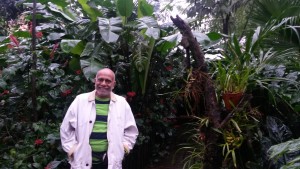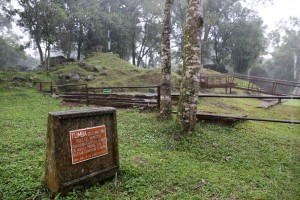published in the Financial Times, October 30, 2015
Jesuit ruins at Santa Ana in Misiones, Argentina
.
The province of Misiones in Argentina is an anomaly — a long finger of land sneaking out from the north-east of the country between Paraguay and Brazil, covered in dense forest and far removed from the wide-open pampas roamed by gauchos and cattle. Most people come here for the Iguazu Falls, which straddle the border with Brazil and have become a stopping-off point on any fast-track gringo trail across the continent, with good flight connections to both Lima and São Paulo. Flying in, you can already see from the plane the huge spumes of spray rising above the jungle as the Iguazu river takes its dramatic plunge.
But further south lie the far less visited ruins that gave the province its name: the Jesuit missionary settlements that for 150 years provided a utopian, if controversial, alternative for native Indians to the slaughter enacted elsewhere on the continent.
Driving down from the falls to visit them, I was struck by how much better preserved the forests of this region are on the Argentine side than the Brazilian. Aside from one police patrol car — whose occupants were too busy drinking mate tea to bother with our speeding taxi — there was hardly any traffic.
Such is their worldwide influence, it is sometimes forgotten that the Jesuits were founded with the express purpose of spreading Christianity to the New World. In the mid-1530s, a young Spaniard, Ignacio de Loyola, learnt that an expedition was to be sent to colonise the lands of the river Plate, so he gathered friends and created the Society of Jesus.
.

When it proved difficult for the Spanish forces to hold down the area around Buenos Aires against local Indians, they moved inland towards Paraguay and the Jesuits went with them. The Guaraní tribe they found there, whose territory extended across the Atlantic forests, proved unusually susceptible to Christianity, and they made many converts. Antonio Ruiz de Montoya, one of the leading Jesuits, is said to have baptised 100,000 Indians.
.
There followed one of the most remarkable assisted migrations in history. Brazilian slave traders were continually trying to capture the Guaraní, so Ruiz de Montoya decided to move them south to safety in new Jesuit settlements along the river Paraná. Sailing downstream in hundreds of canoes, the men, women and children of the tribe had to bypass the great waterfalls of Guairá and escape the traders who attacked them from behind palisades.
The eminent historian of the Amazonian Indians, John Hemming, has described what a magisterial sight this must have been as they “glided down the broad grey rivers of the Paraná, each canoe filled with white-robed Indians, some with a black-gowned Jesuit under an awning amidships, with the congregation breaking into religious song to raise its spirits and inspire the rowers”.

.
On arriving at San Ignacio Miní, the most restored of the surviving mission settlements, I was struck by the scale and vision of the Jesuits. In addition to a central church, they built workshops and carved orchards out of the jungle. The Indians working on the plantation had relatively short working days of six to seven hours compared to the near perpetual servitude in mines and fields elsewhere on the continent. All this was done with the close co-operation of the Guaraní — indeed often there were just two Jesuit priests in a settlement of thousands of Indians and administration would take place jointly between priests and local caciques (rulers).
I wandered around the large central plaza past swallowtails and yellow flycatchers. My local guide, Marcelo Sanchez, told me that one of the most startling consequences of the Jesuit conversions was the Guaraní adoption of monogamy; although he added that the Jesuit policy of insisting on early marriages at about 15 in order, as they wrote, “to avoid many evils”, was problematic.
Sanchez and I went together to the nearby settlement of Nuestra Señora de Loreto, less restored than San Ignacio Miní but the largest mission in the region. By 1700, Loreto had overtaken Buenos Aires in size, with a population of about 7,000. Only the three central hectares of this site that once sprawled across 72 have been recovered from the jungle, although work has picked up now thanks to renewed funding and there is a new museum. As Sanchez drily commented, it helps that the Catholic world has for the first time a Pope who is both Argentine and Jesuit.
The deserted ruins had tremendous atmosphere. When I visited it was pouring with rain, and the giant trees and lianas that had grown up over the buildings were shining. Sanchez told me that he was of mixed blood, like many in the region: mainly Guaraní but with German and Portuguese ancestry as well. “We’re like a salad in this state — all mixed up.”
He stopped to show me a small herb he called isipo growing over a set of circular steps leading up to a ruined gate. “This herb was a favourite of my grandmother’s. It was an aphrodisiac. She needed it as she was 16 when she married my 65-year-old grandfather. And it worked — they had four children.
I nodded politely. It was hard to know quite what to say in response.
In the grass near the ruins was a small memorial stone to Antonio Ruiz de Montoya — much loved by the Guaraní for leading them to safety and petitioning Spain for their continued legal protection. It was here at Loreto that the first printing press was established in Latin America. The Jesuits ensured that some books were printed in Guaraní. Ruiz de Montoya himself compiled a comprehensive dictionary of the language that is still acclaimed by linguists.
When I visited a third settlement nearby, Santa Ana, the sheer ambition of the civilisation brought here by the Jesuits became apparent — each mission settlement had a huge central plaza and fine baroque architecture, often with native Guaraní elements woven into sculptures. Where else would you see a carved angel playing the maracas?
.
Nevertheless, the Jesuit settlements were controversial. Were they preserving the Guaraní or exploiting them? Many natives resisted the approaches of the Jesuits, preferring to take their chances in the jungle against the slave traders but keep their ancient customs.
Voltaire — a lifetime opponent of the order since his education at their hands — wrote a caustic passage in which Candide travels to the area: “It is an admirable thing, this government. The kingdom is more than 300 leagues across. It is divided into 30 provinces. Los Padres [the Jesuits] own everything in it and the people have nothing; ’tis a masterpiece of reason and justice.”
The time came when the kings of Spain and Portugal were no longer happy with what they saw as the meddling interference of the Jesuits. The Treaty of Madrid in 1750 redrew the boundaries of Brazil and the Spanish territories, effectively cutting the mission lands in half. Those Guaraní assigned to Brazil rebelled at the thought of being taken for slaves and one of the last indigenous uprisings against Europeans, the Guaraní war of 1753-56, resulted in the slaughter of the battle of Caibaté: 1,400 Guaraní died compared with only three of their Spanish and Portuguese attackers. This war was later memorialised in The Mission (1986), although the film gives a hyperbolic view of events. By 1767, the Jesuits had been expelled from Spanish and Portuguese territories and the missions fell into disrepair.
Contemporary Argentine attitudes to the Jesuits are mixed. Not until 1940 was San Ignacio Miní, the most accessible site from the river, visited by some architects from Buenos Aires who initiated the slow process of restoration. But the majority of the other settlements have either been subsumed under new towns or lost in the jungle.

When I first visited the falls of Iguazú 20 years ago, I came with a friend, John Fernandes, who had long dreamt of establishing a guesthouse there in the jungle. That dream has since come to fruition and his Secret Garden is a small, exclusive place from which to visit both the falls and the missionary settlements. John has used his time to produce a small monograph on the history of the Jesuit missions and while we celebrated our reunion in his tropical garden with champagne and pizza, he told me how strange it was that the Jesuit legacy was still so undervalued and ignored.
The story of native Indians being treated badly by Europeans is hardly novel in Latin America. From Mexico to Patagonia the same thing happened. But what makes the story of the Guaraní so peculiarly heartbreaking is that for some 150 years the process was reversed. Until the Jesuits were expelled, the Guaraní did enjoy a standard of life high enough for them to rebel at the prospect of losing it due to the arbitrary redrawing of lines on a map in Europe.
One reason the Jesuits built the missions here was to exploit the nearby wetlands in the neighbouring province of Corrientes, where they could keep cattle as it was less disease-prone than the forests. I ended my trip with a visit to those wetlands, with their fabulous wildlife: capybara, caimans and kingfishers. As I glided along the canal of San Miguel, cut by the Jesuits, I reflected on how the jungle has always had a capacity to ruthlessly obscure the best attempts of man to cultivate it, whether it be the Maya in the Yucatán or Henry Ford in his Brazilian rubber plantation. The achievements of the Jesuits have been shrouded by both vegetation and prejudice for centuries — but, slowly, they are being revealed to the light once more.
Hugh Thomson’s books on Latin America include ‘The White Rock’, ‘Cochineal Red’ and ‘Tequila Oil’ (Weidenfeld & Nicolson). His recent radio series ‘Two Men and A Mule’ is available at bbc.co.uk
.

Details
Hugh Thomson was a guest of Audley Travel, the airline Latam and the Nuss hotel, Buenos Aires. Audley offers a week’s tour of the missions and wetlands from £3,230 per person, staying at the Puerto Valle wildlife lodge in the Ibera Wetlands and theHotel Puerto Bemberg on the Paraná river and including a private guide, transfers and flights from London. For independent travellers, John Fernandes’ guesthouse,The Secret Garden in Puerto Iguazú, makes a good base. ‘Exploring Utopia’ (2015) by John Fernandes and Andrew Graham-Yooll is published by Aurelia Rivera Libros.



I saw the movie “The Mission” and hyperbolic or not (in the eye of the beholder) the history it portrayed was heartwrenching. Another place where Europeans came, took, then again, destroyed the cultures and lives of the natives, the owners of the land.
The score by Ennio Morricone is stupendous; I’d list other huge, great descriptive words, but I don’t know them. His music captures the beauty, strength, and majesty of the Falls, and with certain beats, measures, pulses incorporates the life of the falls with the lives and culture of the Guarani.
The theme is: https://www.youtube.com/watch?v=fy-POlABm8Y&list=PLLFO8OvoikEzVYrFQ5pIuiwB6zKu_BCEm&index=2
Later I came to see the Falls. I was overwhelmed by the beauty, the power, the sounds of them. Being there was one of the best experiences of my life. I read, somewhere, that Eleanor Roosevelt visited them, and shook her head, sadly, admitting they made Niagra Falls seem very small. (Or words to that effect.) I would go back in a minute — but at my age the travel would be too much. Go, experience them if you have the opportunity.